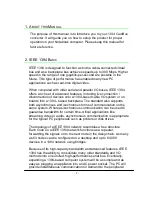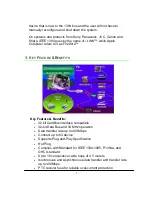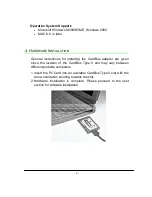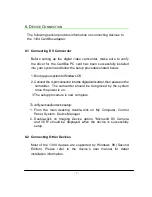
- 2 -
1. A
BOUT THIS
M
ANUAL
The purpose of this manual is to introduce you to your 1394 CardBus
converter. It will guide you on how to setup the product for proper
operation in your Notebook computer. Please keep this manual for
future reference.
2. IEEE
1394
B
ASIC
IEEE 1394 is designed to function as both a cable-connected virtual
bus and as a backplane bus achieves speeds up to 400 Mbps. Higher
speed in the range of one gigabits-per-second are possible in the
future. This type of performance has enabled many new PC
applications such as real-time digital video.
When compared with older serial and parallel I/O buses, IEEE 1394
offers a rich set of advanced features, including live connection /
disconnection of devices onto a 1394-based cable I/O system or on
boards into a 1394 - based backplane. The standard also supports
both asynchronous and isochronous forms of communication on the
same system. Whereas isochronous communication can be used to
guarantee bandwidth for certain time-critical applications like
streaming video or audio, asynchronous communication is appropriate
for the typical PC peripherals such as printers or disk drives.
The topology of a IEEE 1394 network resembles a tree structure.
Each node on a IEEE 1394 network functions as a repeater,
forwarding the signals on to the next node in the daisy-chain. As many
as 63 nodes can be configured on a desktop and up to 64,000
devices in a 1394 network using bridges.
Because of its high-capacity bandwidth and advanced features, IEEE
1394 has the ability to consolidate many older standards and I/O
methods into one unified, high-performance serial bus. Eventually,
expanding a 1394-based computer system will be as simple and as
easy as plugging an appliance into an AC power socket. The PC will
provide instantaneous communication on demand to the peripheral


























